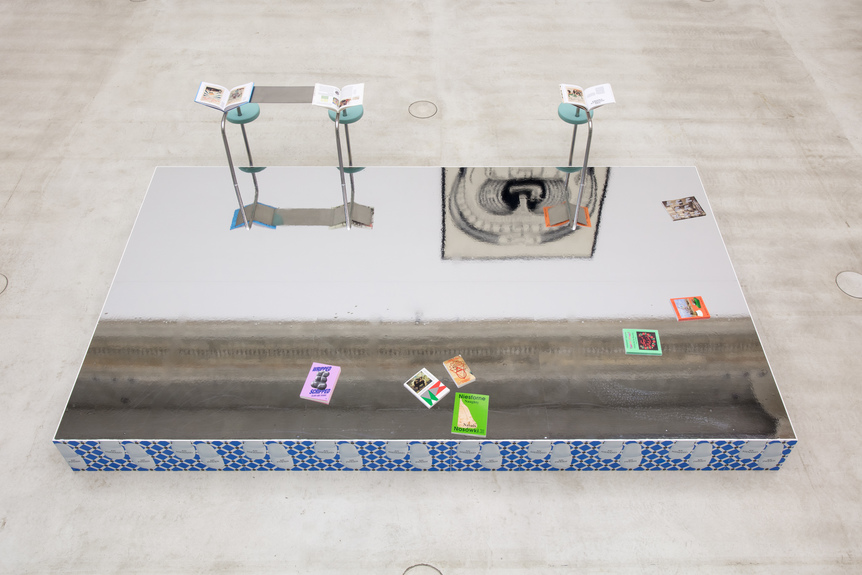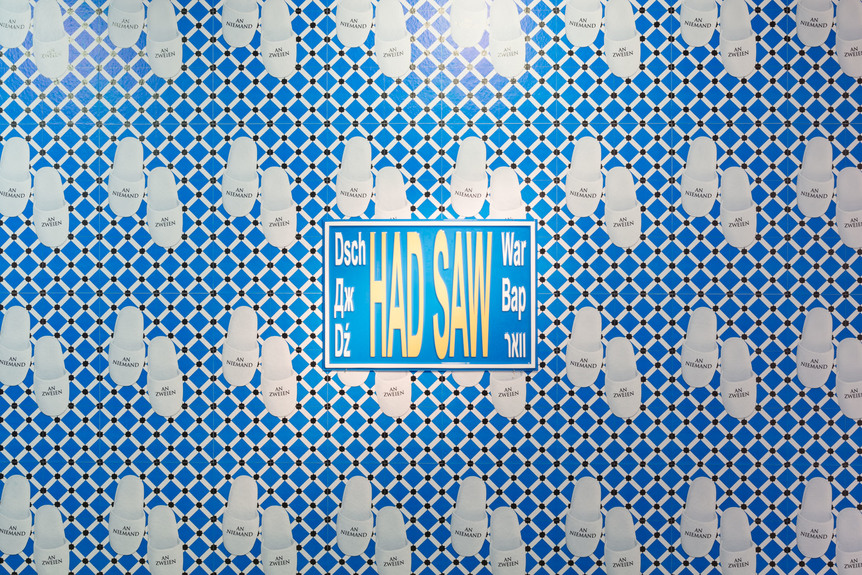-
From Current Issue
-
- Editor’s Letter Fire in the Heart
- Reviews I Gusti Ayu Kadek Murniasih
- Reviews 11th Seoul Mediacity Biennale: “One Escape at a Time”
- Dispatch Networked China
- One on One Monira Al Qadiri on Yukio Mishima
- Essays The rise of independent art spaces in pandemic-era Shanghai
- Features Tuan Andrew Nguyen
- Table of Contents
- Web Exclusives
- Archive
- Subscribe

R
E
V N
E
X
T
Installation view of SLAVS AND TATARS’ “Made in Dschermany” at Kunsthalle im Lipsiusbau, Dresden, 2018. Photo by Klemens Renner. Courtesy Staatliche Kunstsammlungen Dresden.
Founded in 2006 as a book club, the Berlin-based artist collective Slavs and Tatars are driven by the frictions found between linguistic systems. With a particular focus on Eurasia, which they define as the “area east of the former Berlin Wall and west of the Great Wall of China,” their interdisciplinary practice ranges from art installations to graphic design, public lectures and extensive publications that traverse fields of research including literature, religion and geography, among others. “Made in Dschermany,” their largest show in Germany to date, extended the group’s interest into German orientalism. Beginning with the dual digraph “Dsch”—the German transcription of the “J” sound, as in the German word “Dschungel,” the etymology of which is traced back to the English “Jungle”—the show draws attention to how foreignness has been dealt with across languages. Presented at the Albertinum museum, located in the city of Dresden, which is the main hub for the right-wing, anti-Islam movement Patriotic Europeans Against the Islamisation of the West (Pegida), the exhibition came at a time and place where re-evaluating otherness should be high on everyone’s agenda—though not without a sense of humor and self-reflection, of course.
Opposite the entrance of the 19th-century building was the tapestry Alphabet Abdal (2015), which was wrapped around a circular steel frame sitting under the museum’s glass cupola. Arabic script—illegible to the majority of local visitors—is woven into the textile against a gradient background of luminous yellow and azure blue. The words translate as: “Jesus, son of Mary, he is love.” Though some might think that Arabic is a strange language to couch the overtly Christian sentiment, the work is precisely a comment on the white-washed, overlooked origins of Christianity and its history in Arabic-speaking countries. The play with presumable opposites was taken further with the sculpture Kitab Kebab (Öko-Dschihad) (2018), which also ostensibly tests viewers’ reading skills. A silver kebab skewer pierces five books about seemingly irreconcilable subjects—from a text on relations between Russia and Germany to an Islam studies textbook. The work resulted from the artists’ explorations on how to more affectively construct knowledge, and proposes that we absorb information not through the brain but via the gut.
The play with the act of reading continued in the main hall. An integral part of the collective’s work is the publication of their multifaceted inquiries and findings after each of their three-year research cycles. The books from their past eight cycles were offered for perusal via site-specific installations, including a mirrored rectangular platform with bookstands and bar-stool like seating buttressed to one side of the structure, as well as a minimal metal-frame with faux-leather padding. Visitors could either privately or collectively indulge in books by the artists, such as Slavs and Tatars Presents Molla Nasreddin (2011), which discusses the early 20th-century Azerbaijani satirical magazine that lampooned concepts of colonialism and the politics of Islamic and Muslim countries from a decidedly local perspective.
The collective’s peripatetic scholarship was further evidenced in the checkered wallpaper overlaid with images of bathroom slippers bearing the words “An Niemand” and “An Zweien” (“To Nobody” and “To Two”), pasted throughout the hall. The meanings of the cryptic phrases are only revealed through further reading. Specifically, visitors had to refer to one of the artists’ publications about 18th-century philosopher Johann Georg Hamann, the “enfant terrible of the Counter-Enlightenment” movement, in the group’s own words, who argued for the bridging of sensibility and reason, and who inscribed in one of his books the witty dedication: “to nobody and to two.” The slippers, too, referred to Hamann and his father’s bathhouse—a manifestation of Slavs and Tatars’ emotive, anti-didactic approach to research and artmaking.
Elsewhere in the exhibition, absurdities arising from mistranslations and miscommunications were highlighted. Four polished metal panels titled Reverse Dschihad (2015) turn the preconceptions surrounding the loaded term “Jihad” on its head. Printed in reverse on the reflective surfaces is the banner of El Dschihad—a publication printed collaboratively by German and Ottoman authorities during World War One in Russian, Arabic and Tatar and distributed among Muslim prisoners, who spoke those languages, to incite fights against the colonial powers of France, Russia and England. Literally mirrored in the work, viewers are left to ruminate on the strategic mobilization of “otherness” via language, as seen in this piece of forgotten history, and reconsider their notions of how the meaning of “Jihad,” which has become synonymous with violence, really came about.
Taking the alphabet—be it Latin, Arabic, or Cyrillic—as a playing field, Slavs and Tatars explore the perceived limitations of vocabulary and culture through centuries of linguistic power plays. Their diverse approaches to media, geographies and disciplines serve the purpose of entanglement—there is no end and no beginning to consonant cacophony or tongue-twisting transliteration in a cultural cosmos beyond man-made borders. “Made in Dschermany” hit a nerve. Specifically, the motor nerve, sending signals of muscular acrobatics to muster the four simple consonants—or was it “DZ,” “дж” and “DJ”?
Slavs and Tatars’ “Made in Dschermany” is on view at the Albertinum, Dresden, until October 14, 2018.
To read more of ArtAsiaPacific’s articles, visit our Digital Library.








